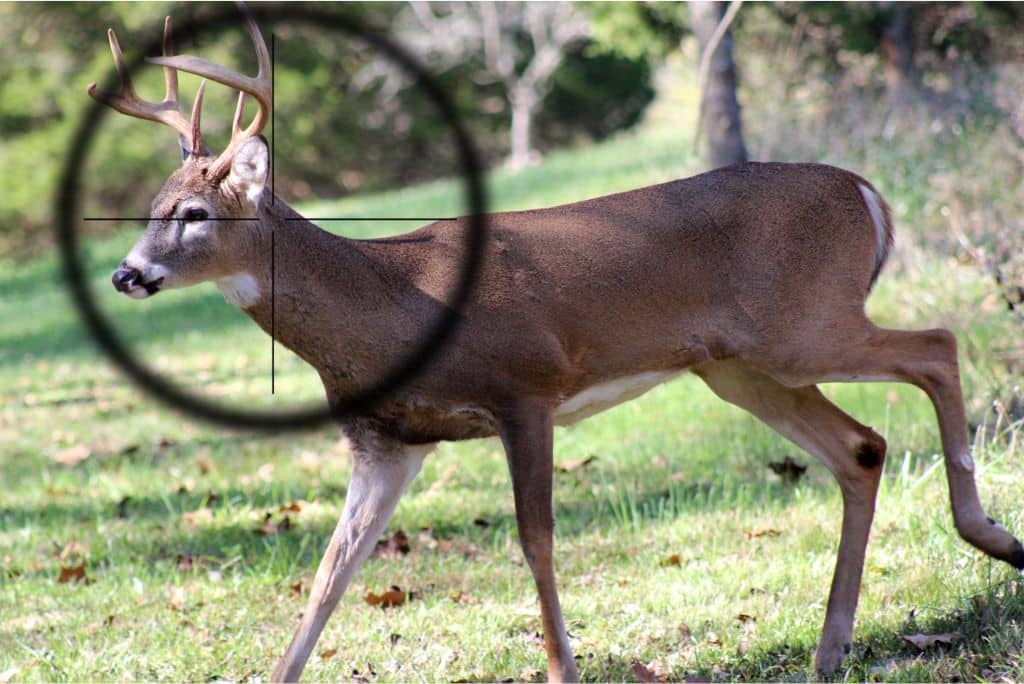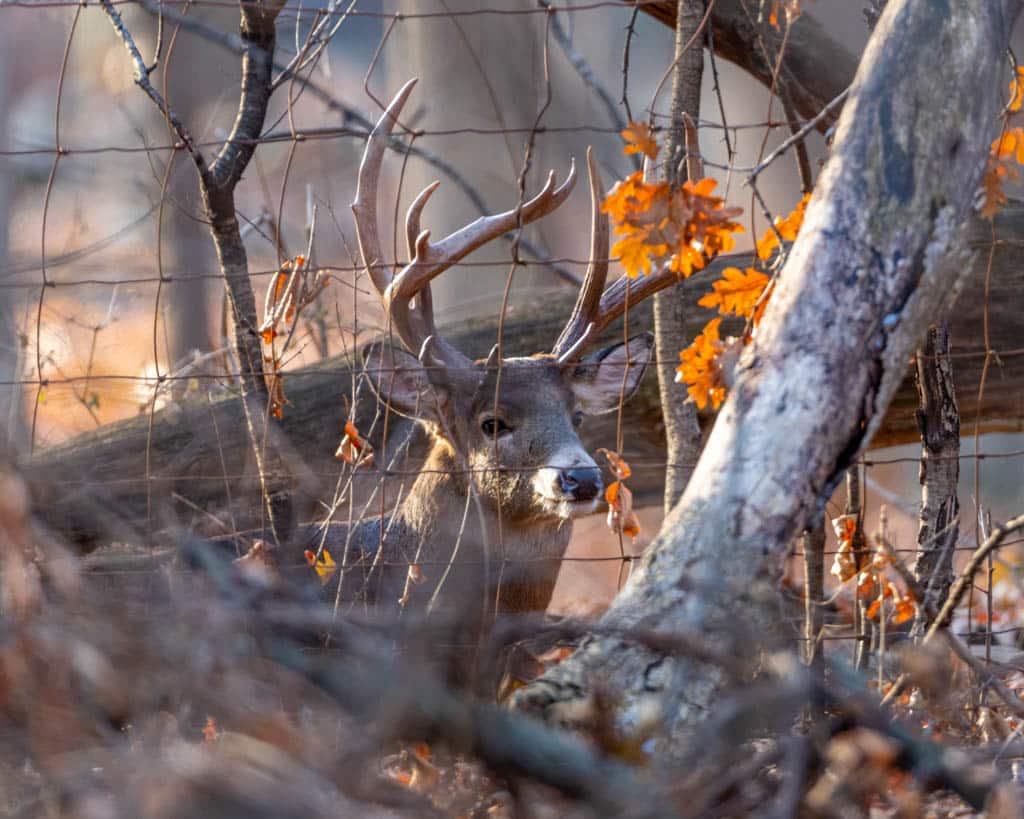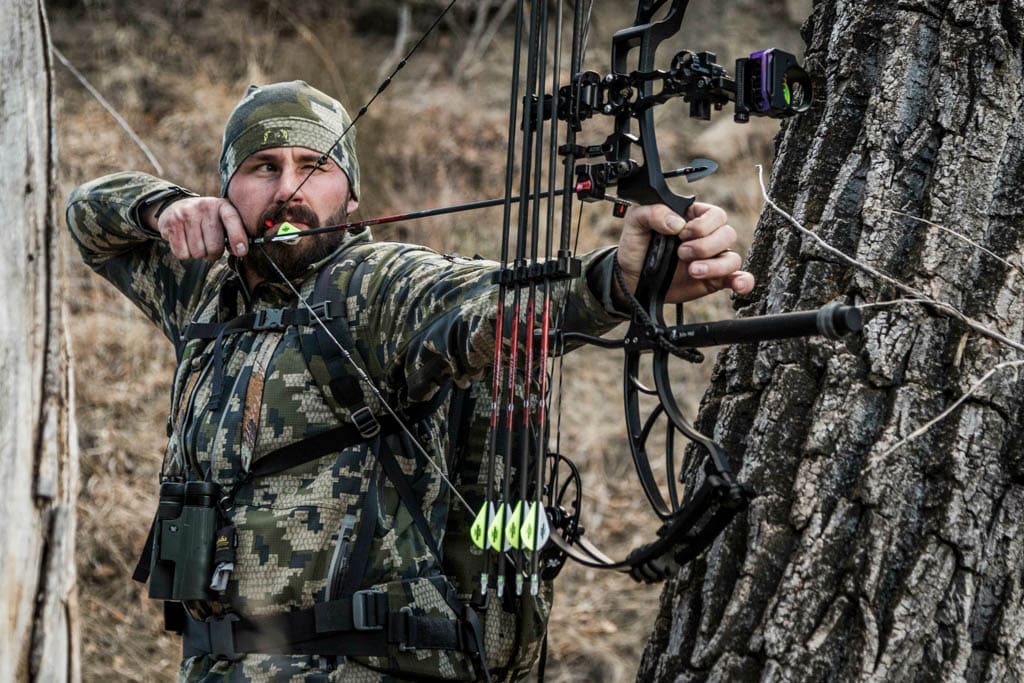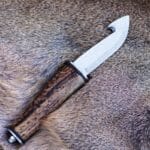You have an accurate rifle with good hunting ammo, perfectly sighted in.
You’re wearing the right gear for the weather so you’re perfectly comfortable in your tree stand.
You’ve even memorized deer anatomy and know just where to aim to hit their heart, lungs, spine, or even brain stem.
And now a deer just barely stepped out from behind a tree and is looking straight at you, with your sights aimed between its eyes.
Should you take the shot?
Don’t fire at a deer that gives you a momentary sight picture. Also, don’t shoot at the deer that presents its nervous system but not the kill zone. Wait for a clean shot where you have a clear view of their heart and lungs. Be sure there are no obstructions like branches or rocks.
Too much can go wrong if you’re not taking a clean shot.
But what exactly do I mean by “clean shot”?
What is a Clean Shot in Hunting?
A clean shot is taken against a deer standing in the way that allows your projectile to pass through and damage the animal’s heart and lungs with little risk of missing.
This means a deer standing broadside to you or quartering away.
Your view of the deer should be clear, without wind-blown branches bouncing in the way. And the deer should be calm, stationary, and unconcerned about your presence.
This maximizes your chances of delivering a blow to those vital organs that kill the animal without causing too much pain and suffering.
A clean shot will devastate the heart and potentially both lungs, causing the animal to bleed out in moments.
Why aren’t Brain and Spine Shots Considered Clean Shots?
Some hunters consider a shot successful if the deer falls immediately, calling it “dead right there” or “DRT.” A prey animal that falls immediately saves you from having to track it down.
And it’s surely more humane, right? Only if you hit precisely where you need to hit. If you miss, even slightly, a brain stem shot won’t kill the deer.
Animal brains are small targets. You may find it easy to hit a small target when shooting off the bench at a level range. That bear, though, won’t be level with you, won’t be at exactly 100 yards, and is moving around.
Too many deer are walking around with their jaw half-blown off because an overconfident hunter wasn’t able to make such a difficult shot.

The nervous system is an effective target, but it’s just too hard to hit when real-world variables are in play. And even neck or spine shots may merely paralyze the animal instead of killing it. You want to put down the animal, not maim it and leave it suffering until the next hunting season!
How Often Do Hunters Miss?
Hunters love sharing stories about how they put down two deer in two shots last hunting season. But nobody brags about all the times they blew apart a branch just above the deer they were shooting at.
It’s hard to find hard data on how frequently hunters miss, though I have seen claims that only 20% of shots taken on the opening day of hunting season hit.
Now, being properly educated and practiced, I’m sure you’re within that 20%.
But keeping in mind that it’s a lot harder to hit an unpredictably moving target, it makes sense for so few deer to be taken in those first hours.
This is an exciting time.
A deer is in your sights! Finally!
Your blood pounds in your ears and adrenaline flows through your body.
It’s all too easy for an ordinarily good marksman to make a wild shot under these circumstances. And even a hit against a deer may be a technical miss.
If you aim for a heart shot and take out the liver, well, the deer will still die. Tomorrow. That’s not a clean kill. It’s more suffering for the animal and more work for you if you can even track down an animal that finally fell twelve hours after the shot.
This is why clean shots are essential. If you miss, even with a clean shot, you may hit close enough to the vitals to harvest the animal. Especially if you’re using the correct cartridge for the animal you’re hunting.
What is the Key to Making a Clean Kill in Hunting?
I’ve seen many reasons why hunters fail to make clean kills: the animal is standing at the wrong angle, or you’re using a too-highly-magnified optic—a bad zero.
But they all boil down to one factor: Impatience.
Too many hunters are impatient to get their animals and don’t pay enough attention to all the steps necessary to make their hunt successful.
The proper patience required for a clean shot starts at home, educating yourself about deer anatomy.
Then it requires patience at the gun range, practicing marksmanship, and learning your projectile’s ballistic path. You need to be familiar with them at all ranges you’re likely to see and for whatever animal you’re hunting.
Most of all, it requires patience in the field.
I know it’s hard to wait for a coyote to show up. But you need more than just an animal to make an effective, ethical shot. You need to wait for your prey to stand at the right angle and in the right place for a clear shot through its vitals.
There are over 30 million deer in the United States. The first deer you see will be followed by a second. Then a third. Then five more. Don’t take a shot against the first deer you see. Wait for a clean shot.
Which Shot Angles should be Avoided?
Though I will give a list of angles and whether they are good or not, you can figure out proper angles by understanding what makes a shot angle good or bad.
Earlier I mentioned the two best angles being broadside and quarter-away shots. This is because these give your projectile the best path through the animal’s vital organs with the minimum amount of bone and flesh in the way.
The more non-organ tissue your projectile has to penetrate before hitting vital organs, the less your chances of damaging those organs. This is why a quartering-to or head-on angle is often a poor choice for a shot.
When an animal is quartering toward you, one of its limbs is likely to block the path to its vitals. Smashing a bear’s shoulder may knock it to the ground, but now you have an angry, crippled animal. That’s not a clean kill!
Also, it’s easy to misjudge angles when taking a shot at an animal quartering toward you. The entrance wound may be in a good place, but the exit wound is likely farther back than you anticipated, meaning you hit flesh and missed vital organs.

Straight-on shots are tempting, but there’s a lot of rib cage between you and the animal’s heart. Those bones can deflect projectiles at worst and slow them down at best.
These angles can still be effective with a powerful-enough cartridge, but that doesn’t make them shots clean. And that’s not just because you’re lowering your chances of killing the animal. You’re also damaging a lot of delicious meat!
Worse still is when the animal is pointed directly away from you.
It’s tough to hit a deer’s heart when your gun is pointed at its tail. You’re more likely to shoot low and miss entirely or, worse still, to make what’s called a Texas heart shot by putting your bullet into the deer’s anus. Such a gut shot is painful and leads to a long, slow, excruciating death.
Common Deer Hunting Angles
- Broadside: Clean Shot
- Quartering Away: Clean Shot
- Quartering Toward: Marginal Shot
- Head On: Marginal Shot
- Tail On: Bad Shot
Note that these angles apply to most animals, not just deer. However, other animals may not present such a clean shot when they’re standing broadside.
For example, deer shoulder bones are shaped like a vertical boomerang, with the tip facing toward their front. This means that, though it may look like their shoulder covers up their heart, there’s actually little blocking the way to that vital organ.
Hog leg bones are more likely to cover their heart, though. You have to pay more attention to their stride to ensure you have a clean shot to the heart.
How Do You Ensure a Clean Kill?
Here are the four main factors that go into a clean kill:
- Skill
- Opportunity
- Mindest
- Gear
Let’s look at these four factors in what I believe to be their order of importance.
Skill
I put skill first because your ability to make a good shot is the most important part of making a quick, clean kill.
You have to know the anatomy of your prey and have the marksmanship to put your bullet or arrow precisely where you want it to go.
Opportunity
Opportunity is second because you can’t make a clean kill without a clean shot, and half of a clean shot is how the animal is positioned.
Is it standing still (or at least moving slowly)? At a good angle? With a clear view between you and the animal?
You can help improve these favorable circumstances by scouting out paths and properly positioning your hunting stand. But when it comes down to it, only the animal itself will give you the optimal shooting opportunity.
Mindset
Making a clean kill involves being prepared to take a clean shot. You need to keep your thoughts on the hunt. Pay attention so you’re not caught in an awkward position when the animal appears.
Then, once the animal is under your sights, your mindset will either leave you with a full freezer or a frustrating night of tracking blood from a gut shot.
It’s important to try to remain as calm as possible. This lets you focus on your marksmanship, which lets you take advantage of the clean shot opportunity to make a clean kill.
Slow your breathing. Double-check your surroundings to make sure there’s an appropriate backstop.
Gear
Gear is the last factor but it can make or break your hunt. Still, it’s the most supportive of the factors.
If you have the right skill, opportunity, and mindset, you can take down a deer with nothing more than a spear and a loincloth.
Everything else should just make your job easier.
I say “should” because some gear, such as a crappy scope or cheap cotton socks, can worsen your hunting experience.
Use a weapon with an appropriate cartridge or arrow type for your target. Be comfortable with that weapon at the ranges you expect to hunt.
Know how to use equipment such as rangefinders and test them on a hike before hunting season starts so you’re confident.
Your weapon is a vital article but it doesn’t discount the importance of your clothing!
If you’re not comfortable or well-camouflaged, you’ll have a harder time staying focused on hunting. This will make it all the more difficult to put down your game cleanly.
Conclusion
It’s easy to get caught up in the excitement of hunting. Finally, after so much preparation, you’re ready and able to shoot that deer!
Hold on a moment.
Have you maximized your chances of making a lethal shot on your deer? A clean shot is one against an animal’s largest vital organs, with little flesh and few bones in the way, while they’re not moving and aren’t behind cover.
An unclean shot is one taken at a bad angle, with foliage in the way, or one taken at the animal’s harder-to-hit areas, such as its brain.
Resist the temptation to shoot at your game merely because you can. Wait for the right time, and you’ll put the animal down cleanly.
It’ll be less stressful for both you and the animal.





